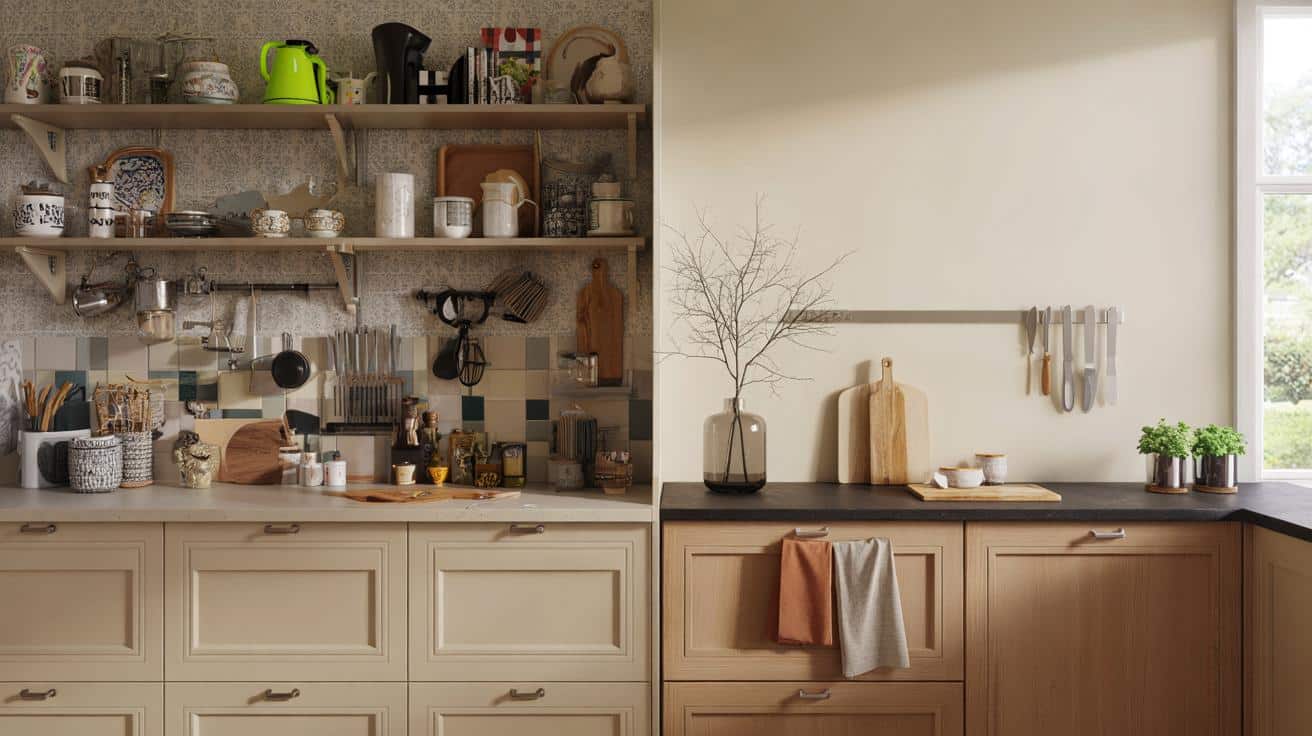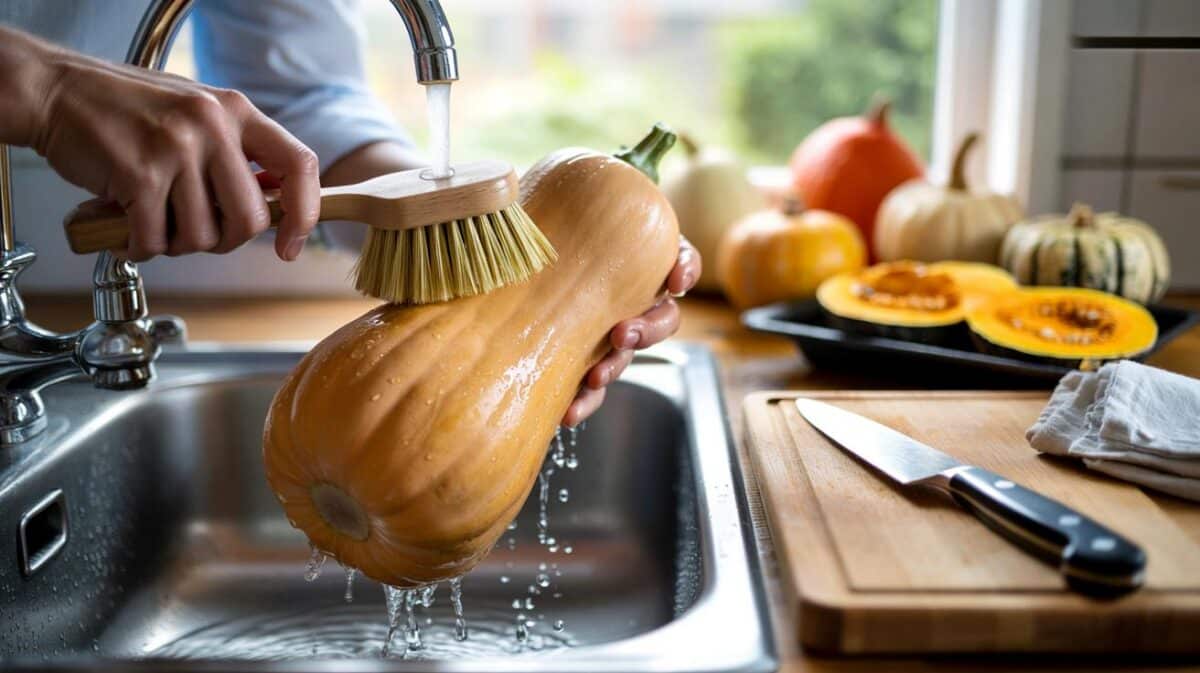You want a space that stays welcoming, looks fresh in pictures, and rides out fads. Designers agree the safest path is a calm, adaptable scheme. Yet one error sneaks in during shopping trips and seasonal styling, and it ages a room fast.
Why timeless beats trend-chasing in a hard-working kitchen
Kitchens carry heavy traffic, sharp light, and daily mess. Trend-led finishes date under these pressures. A timeless base absorbs change. It frames daily life without shouting for attention, whether you are stirring soup or hosting friends at short notice.
The trap of fast trends that date the room
Bold feature colours, novelty handles, and hyper-patterned wallpapers look thrilling at first glance. They tire quickly. In a year or two they clash with new appliances, gifts, or table linen. The room starts to feel staged rather than lived in.
Open shelves packed with mismatched ceramics, neon kettles, and seasonal trinkets add visual noise. That noise kills calm. Light feels heavier. Corners look busy. The space seems smaller.
Timeless kitchens win on quiet confidence: a restrained base that carries small, seasonal tweaks without drama.
Reasons to favour a calm, adaptable base
A soft palette builds versatility. Think warm whites, greige, and mid-tone woods. Straight lines and flush fronts reduce visual fuss. Natural textures add depth without clutter. You can then switch tea towels, runners, or a vase of branches and the room still reads as one story.
The mistake the pros dodge every time
The repeat offender is visual clutter. Not dirt. Not wear. Clutter. It creeps in through duplicated tools, decorative fillers, and displays without a colour thread. When every surface carries objects, the eye cannot rest. That is the point where a kitchen looks dated in photos and harsh in real life.
How clutter kills comfort and signals a dated look
Stacked décor and jammed shelves hide your joinery. Statement lights fight with busy tiles. Multiple metal finishes compete. The room loses hierarchy. Guests sense stress, not warmth. Cooking slows because you must move things just to chop vegetables.
Less on show, more in use: edit displays to one material family, then store the rest out of sight.
Seven quick tests to spot overdecorating
- Count your worktop objects; if more than one item per 60 cm run, you likely have too much out.
- Open shelves: if you cannot remove one piece without moving another, the shelf is overfilled.
- Colour count: more than three dominant colours in one sightline creates visual chatter.
- Mixed metals: stick to one hero finish and one supporting finish at most.
- Duplicate tools: one spatula shape in two sizes is useful; five versions is display creep.
- Theme overload: seasonal pieces should sit in a five-minute box, not a cupboard of props.
- Cleaning time: if clearing surfaces takes more than five minutes, storage needs a rethink.
Materials that guarantee mileage without boredom
Designers lean on mid-tone wood and stone for a reason. The pair looks grounded, suits daylight shifts, and survives fashion cycles.
Mid-tone oak cabinetry with plain fronts
Flat-front doors and push-to-open rails keep lines calm. A medium oak tone brings warmth without gloom. The grain adds movement, so the room never feels flat. Pale timbers can wash out under winter light. Very dark woods shrink space in British homes. Mid-tone splits the difference.
Stone worktops in crisp white or deep black
Marble, granite or quartz in white or black sets a clean edge against wood. The contrast frames sinks and hobs, so tasks feel organised. The palette works with copper, brass or stainless hardware. It also accepts both rustic chopping boards and sleeker gadgets without friction.
Wood for warmth, stone for structure: this two-material recipe reads classic today and steady in five years.
| Material | Best for | Approx. cost per metre (UK) | Care level | Expected longevity |
|---|---|---|---|---|
| Quartz worktop | Busy cooks, stain resistance | £300–£600 | Low | 15–25 years |
| Granite worktop | Heat tolerance, natural pattern | £250–£500 | Medium (seal as advised) | 20–30 years |
| Marble worktop | Soft veining, classic look | £300–£700 | Medium–high | 15–25 years |
| Mid-tone oak veneer doors | Warmth and budget control | £60–£140 | Low–medium | 10–15 years |
| Solid oak doors | Tactile feel, repairable | £140–£300 | Medium | 15–25 years |
| Stainless splashback | Hygiene, easy wipe-down | £120–£250 | Low | 15–25 years |
Care tips that keep the look steady
- Wood: wipe with diluted black soap or a gentle cleaner; feed with linseed oil as needed.
- Stone: use pH-neutral sprays; avoid harsh acids; reseal natural stone per supplier guidance.
- Metals: match polishes to the finish; test on a hidden spot first.
- Textiles: choose linen or cotton that machine-wash at 40°C; store spares flat to prevent creasing clutter.
Seasonal updates without the slide back into clutter
Set a strict palette for accents. Pick one warm tone and one texture for the colder months. Keep counts lean.
- One linen runner, two tea towels, one vase with branches, one board on show.
- Swap scents, not objects: a clove candle in winter, citrus in spring.
- Rotate plants by size; never exceed three live pieces in one sightline.
A 20-minute weekend audit that resets the room
Grab a timer. Clear every worktop item into a box. Put back only tools used daily. Rehome the rest in drawers or a single lidded crate. Photograph the kitchen from the doorway. If you see more than three contrasting colours, remove one group. Label one shelf for seasonal décor; when it is full, stop buying. This routine keeps the base calm and the style current.
Helpful extras people miss when planning storage
Estimate cupboard needs with a simple rule of thumb: allow 1.2 linear metres of base cabinet per person, plus 0.6 metres for shared kit such as mixers or slow cookers. Add a tall pantry if you bulk-buy dry goods. Fit one shallow drawer near the hob for utensils, one deep drawer for pans, and a narrow pull-out for oils. These zones cut surface parking and speed up meal prep.
Budget-smart swaps make a visible difference. Replace four ornate handles with discreet pulls for under £50. Add a magnetic strip to wall-mount knives and free a full drawer. Fit a single rail with S-hooks for daily mugs and strainers, then keep the rest hidden. Small, cheap adjustments deliver the quiet look professionals aim for while keeping your kitchen ready for real life.








